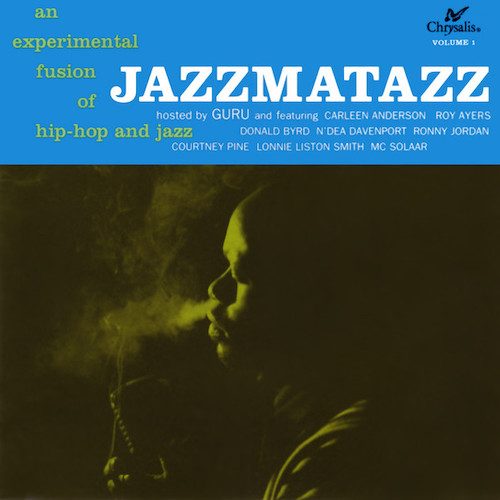After a recent review of Gang Starr’s album “One of the Best Yet” featuring posthumous Guru vocals, I started thinking more about Guru’s catalogue of work both inside and outside of his best known tandem with DJ Premier. We’ve covered a few of those entries over the decades including albums like “Baldhead Slick & Da Click” and “8.0: Lost & Found“, but Keith Elam is best known outside Gang Starr for the Jazzmatazz album series. As a younger Flash I viewed these releases as a natural extension of the jazz & hip-hop fusion Gang Starr created, done so that Guru could rap with live musicians instead of flowing to samples of their work. Now that I’m older I also realize these albums also owe a debt to the creative differences that made it hard for Gang Starr to see eye to eye, frequently extending the number of years between releases for what is still one of my all time favorite rap groups.
“Peace yo, and welcome to Jazzmatazz – an experimental fusion of hip-hop and live jazz. I’m your host the Guru, that stands for Gifted Unlimited Rhymes Universal. Now I’ve always thought of doing something like this, but I didn’t want to do it unless it was gonna be done right – know what I’m saying?”
Guru’s words in the introduction seem much more telling in retrospect. It’s implied here without being directly stated as such that Guru would not have launched this series without complete creative control over every part of the endeavor, and the fact he named it “Vol. 1” indicated right from the jump it would be an ongoing series. This wasn’t really an extension of Gang Starr at all – it was meant to be Keith Elam’s complete artistic vision done his way and “done right” in his own words. He does indeed do it right on the opening track/lead single “Loungin'”, a collaboration with jazz legend Donald Byrd playing trumpet like only he can.
This perfectly sets the tone and vibe for the rest of the album’s musical collaborations. Guru’s production proves him to be just as smooth behind the boards as on the mic, but it doesn’t get much smoother than the sultry N’Dea Davenport singing on “When You’re Near” or cooler than Branford Marsalis blowing the saxophone on “Transit Ride”. Then as now I’m struck by the irony of Branford’s younger brother Wynton Marsalis hating rap music so much. Wynton’s never been shy about expressing his opinion, which always made me think Buckshot LeFonque was Branford flipping his brother the middle finger. Family Thanksgiving must be interesting.
“No Time to Play” featuring Dee C. Lee and Big Shug on vocals (yes that’s really him crooning at the end) and Ronny Jordan on guitar was the album’s other big single. Understandably that might be where the proceedings ended for a lot of listeners, but for me the second half of “Vol. 1” is even more fascinating. Hearing Lonnie Liston Smith tickle the ivories on “Down the Backstreets” as Guru kicks his “wild monotone style”, one which he always said was best suited to the strains of jazz music, is cooler than a polar bears toenails, knahmean?
“So when you’re lookin for me, here’s where I’ll be
I’ll be walkin down the backstreets in your vicinity
Cause I been out here for a few
So all that you’re doin, ain’t really nothin new (nothin new)
I peeped the way you always perpetrate
You’re so phony, you make me wanna regurgitate
Since you’re ridin so high, you’re bound to fall
while I stand tall, and you don’t get no props at all out here”
Since I was only 18 when this album came out, the entire presentation was like an education into the world of jazz I only knew from the samples that snuck into rap tracks between P-Funk and rock music. Hearing Roy Ayers play vibraphone on “Take a Look (At Yourself)” is as much a pleasure now as it was then, and I didn’t even know what a vibraphone was back then. “Slicker Than Most” could be mistaken for a Gang Starr B-side if you’re not looking too close, but there’s Gary Barnacle playing saxophone and flute. I lucked out to have a pen pal who introduced me to MC Solaar before this album, but hearing him kick bars on “Le Bien, Le Mal” was still eye opening.
In the back of my mind I’m sitting here pondering whether I’m truly objective about this album given it was such a fundamental part of my youth, let alone the fact I still mourn Keith Elam’s passing almost a full decade after he left us. The problem is that try as I might I simply can’t find a misstep or a mistake that Guru made anywhere along the way in his plan to make sure fusing rap and jazz was “done right” on “Jazzmatazz Vol. 1“. N’Dea Davenport was good enough to be featured twice (let alone more) so “Trust Me” is just as good as “When You’re Near”. The sorrowful “Sights in the City” has so many features I won’t even list them all but they’re ALL good. Even the interludes like “Respectful Dedications” are cool as fuck.
The best part about going back to this album again may simply be hearing Guru at his prime, before the years had taken their toll on his mental state and mellow vocal tone. In the end I’ve just got to flat out tell you that for 44 minutes and 17 seconds I can’t find a single complaint to give you about “Jazzmatazz Vol. 1“, so if you only knew about Gang Starr and never sought out Guru’s solo projects before now, there’s no better one to start with.

